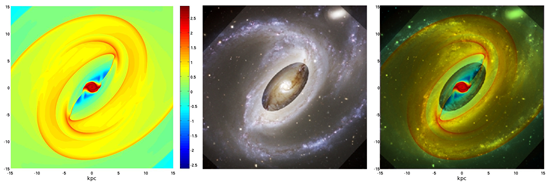HYDRODYNAMICAL SIMULATIONS OF THE BARRED SPIRAL GALAXY NGC 1097

A comparison between the numerical simulation result and the observation of NGC 1097. Left panel: The projected surface density distribution of the simulation result. Middle panel: Optical image of NGC 1097 taken with the Visible Multi-Object Spectrograph (VIMOS) instrument on the 8.2-m Melipal (Unit Telescope 3) of ESO's Very Large Telescope. Right panel: Superposition of the left two figures. North is at the top and east is to the left.
The circumnuclear starburst ring, the northwest dust lane, the two lateral spiral arms along the bar region, and the southwest main spiral arm are reproduced by the simulation in both their shapes and locations. The circumnuclear ring is reproduced by the tightly wound inner parts of the spirals excited at the OILR and is located inside the OILR as expected (Athanassoula 1992; Piner et al. 1995; Maciejewski 2004; Yuan & Yang 2006). The lateral arms along the bar region correspond to the 4:1 ultraharmonic spirals in our simulation. The lateral spiral arm on the southwestern side in the observation reveals that dust is distributed on the concave side of the spiral and that the bright OB stars lie outside the dust. This is consistent with the theory (e.g., Roberts 1969) that inside the corotation radius dust coincides with the shock on the concave side of the spiral arm, gas is compressed by the shock, and after the gas has passed through the shock luminous stars are formed. The shock associated with the 4:1 ultraharmonic arm in our simulation coincides with the observed dust and bright OB stars lying behind the shock. For the main spiral arms outside the bar region in the optical image, the southwest spiral arm coincides with the spiral excited at the OLR in our simulation. However, the spatial extent of the north-east spiral arm is not as large as the arm in the southwest and is marked by a discontinuity. In fact, only a small portion of the observed arm matches with the simulated spiral excited at the OLR. Since the northern half of NGC 1097 is likely influenced by NGC 1097A, the complexity and asymmetry of the feature in the observation is difficult to simulate within the framework of our simple model. (Lin et al. 2013, ApJ, 771:8)